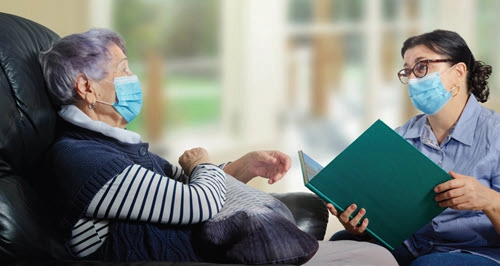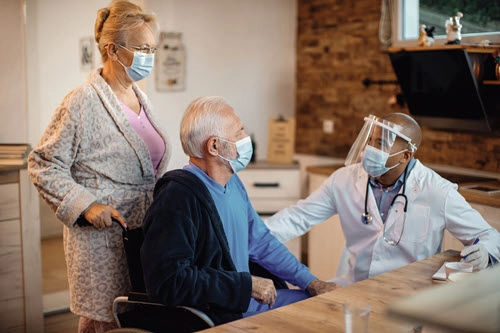MDS Alert
Understand How Vaccinations Affect Visitation
Don’t expect “normal,” but hope is on the horizon. Although some long-term care facilities are still struggling with getting staff vaccinated, the Centers for Disease Control and Prevention (CDC) and Centers for Medicare & Medicaid Services (CMS) are advising facilities to resume indoor visitation — with some limits. “Facilities should allow indoor visitation at all times and for all residents (regardless of vaccination status), except for a few circumstances when visitation should be limited due to a high risk of COVID-19 transmission (note: compassionate care visits should be permitted at all times),” says David R. Wright, director of the survey and certification group at CMS. Note These Exceptions Although the impact of vaccination has had an outsize effect on COVID-19 infection rates in the long-term care industry, there are still situations in which facilities will need to make virus-conscious accommodations. You should limit indoor visitation for residents in these situations: Per the CDC, “fully vaccinated” means the resident is at least two weeks past their second dose in a two-dose COVID-19 vaccination series or at least two weeks past their vaccination for a one-dose vaccine. Even though indoor visitation has a greenlight, the CDC still recommends that everyone physically in a facility, from staff to residents to residents’ families, still abide by the precautions for avoiding COVID-19 transmission, like wearing masks and maintaining 6 feet of distance, especially if any individuals have not yet been fully vaccinated. “However, we acknowledge the toll that separation and isolation has taken. We also acknowledge that there is no substitute for physical contact, such as the warm embrace between a resident and their loved one,” Wright says. If a resident is fully vaccinated, they can choose to engage in physical contact — as long as they wear a “well-fitting mask and performing hand hygiene before and after.” Facilities shouldn’t require that visitors be tested or vaccinated or be made to show proof of either, Wright notes in the memorandum. But don’t restart the resident chamber choirs just yet. Wright recommends that residents continue distancing from each other and staff for now. Be Careful During an Outbreak Right now, CMS defines an outbreak in a facility as a new COVID-19 infection occurring from “nursing home onset,” or when staff or a resident catches COVID-19 from someone else in the facility. In this situation, Wright says that facilities should suspend visitation — except for compassionate care situations and visitation rights as defined under disability rights law — until “at least one round of facility-wide testing is completed.” If the facility-wide testing shows that COVID-19 is contained within a single area or unit, visitation can resume in other areas where there are no positive cases but should remain suspended in the affected unit until the facility no longer needs to conduct outbreak testing. If the facility-wide testing shows that there are one or more COVID-19 infections in other areas of the facility, suspend visitation for vaccinated and unvaccinated residents until the facility meets the criteria to stop outbreak testing. Facilities should continue to follow other aspects of COVID-19 infection prevention, infection control, and notification of infection, none of which have changed with the updated guidance for visitation. Understand Why Some Expert Advice Sounds Conflicting If residents are asking why they cannot return to life as normal, now that they’re vaccinated, you can reassure them that it’s probably just a matter of time. Data is now coming in that suggests that the Pfizer and BioNTech vaccine significantly reduces both symptomatic and asymptomatic infections. “Vaccine effectiveness was at least 97% against symptomatic COVID-19 cases, hospitalizations, severe and critical hospitalizations, and deaths. Furthermore, the analysis found a vaccine effectiveness of 94% against asymptomatic SARS-CoV-2 infections. For all outcomes, vaccine effectiveness was measured from two weeks after the second dose,” according to a March 2021 press release by Pfizer Inc. and BioNTech SE, referring to data and analyses coming out of Israel. With the fast-tracking of the vaccines for emergency authorization and use, the studies were designed to measure the vaccines’ efficacy in reducing severe disease, hospitalization, and death, all of which correlate with symptomatic infections. With the real-world data that is increasingly available, experts are observing that asymptomatic infections are also on the decline, suggesting that vaccinations are effective in reducing transmission. Right now, we know that fully vaccinated people are not getting sick from COVID-19, but we’re also seeing that a person who is fully vaccinated probably cannot carry or pass on the virus, hence the reduction in asymptomatic infections as well. “The findings [that] suggest that the vaccine may also provide protection against asymptomatic SARS-CoV-2 infections are particularly meaningful as we look to disrupt the spread of the virus around the globe,” said Luis Jodar, Ph.D., senior vice president & chief medical officer for Pfizer Vaccines, in the press release. The vaccination rollout data specific to nursing homes is encouraging, too: The American Health Care Association and National Center for Assisted Living (AHCA/NCAL) released a report showing an 82 percent drop in COVID-19 cases in nursing homes from Dec. 20, 2020, to Feb. 7, 2021. Once there’s more data confirming these hypotheses, staff, residents, and residents’ loved ones should be able to stop wearing masks or maintaining physical distance when fully vaccinated. Consider using this information poster for residents and visitors www.cms.gov/files/document/visiting-love-ones-nursing-home.pdf. Read the report on vaccination data for nursing homes at www.ahcancal.org/News-and-Communications/Fact-Sheets/FactSheets/Report-Nursing-Homes-Cases-Feb7-2021.pdf.


MDS Alert
- COVID-19:
Understand How Vaccinations Affect Visitation
Don’t expect “normal,” but hope is on the horizon. Although some long-term care facilities are [...] - Workplace Safety:
Be Prepared for More Intensive SNF, NF Scrutiny
Know what federal agencies and Congress are looking into. The Occupational Health and Safety Administration [...] - Back to Basics:
Know Which Assessments Should Be on Your Radar
Keep these handy charts to differentiate various MDS assessments. Nurse assessment coordinators (NACs) and other [...] - Reader Questions:
Brush Up On What Other Credentials ‘Physician’ Includes
Question: When I’m working on the Minimum Data Set (MDS), what does the word “physician” [...] - Reader Questions:
Know These Facts About Optional State Assessments
Question: How is the Optional State Assessment (Item A0300) different from the other assessments I [...] - Reader Questions:
Don’t Mix Vaccination Records
Question: I work at an independent skilled nursing facility, the only one in my rural [...]

